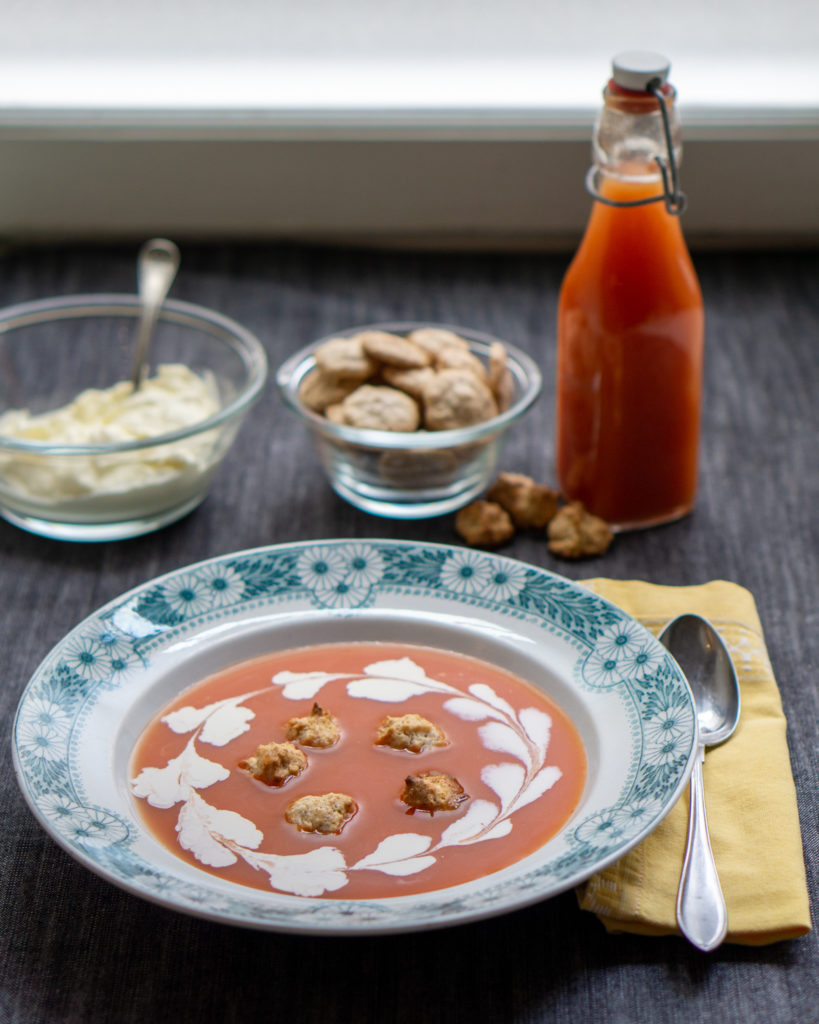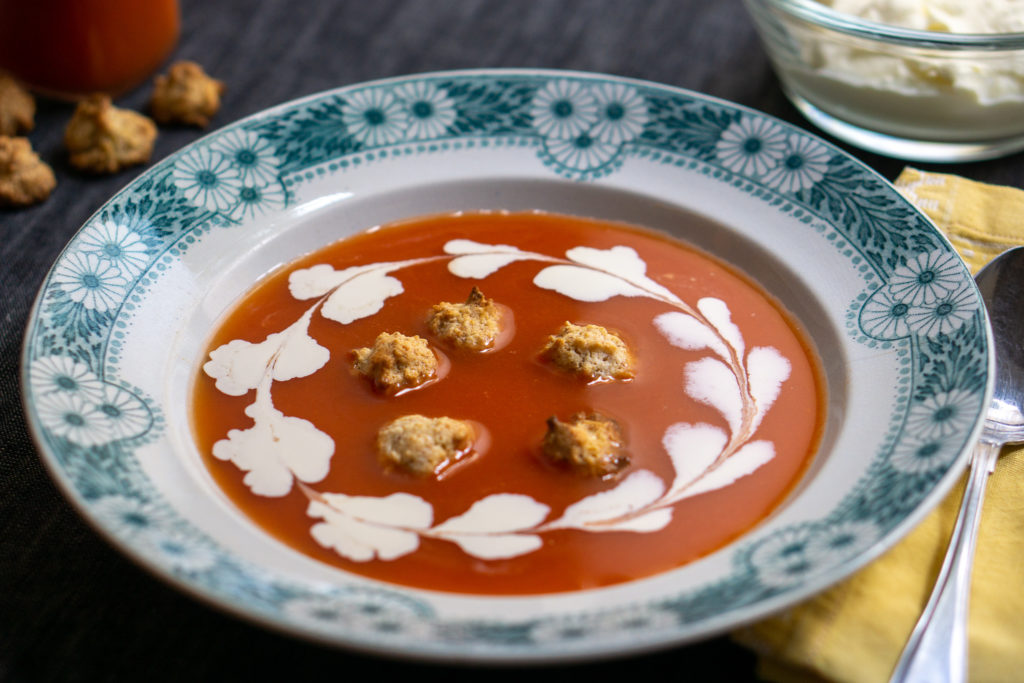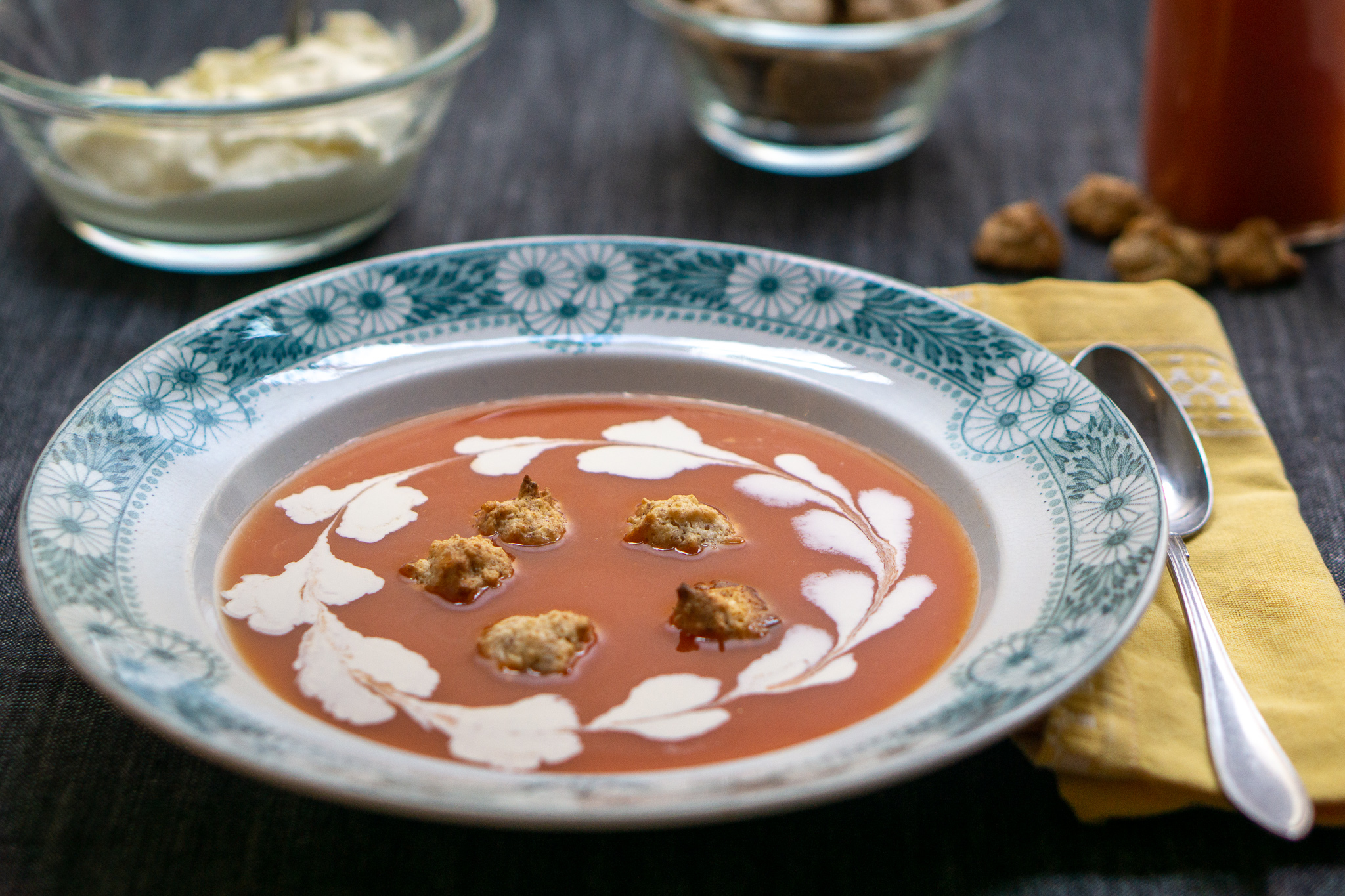Rosehip soup with almond macaroons—nyponsoppa med mandelbiskvier
Not all dishes get the attention they deserve. Because what happened to real, homemade rosehip soup?
Maybe Swedes can blame the ready-made packs of soup for injuring the memory of our sensitive tastebuds. But the underestimated rosehips have their main fan base in the Nordic countries. Food historian Jan-Öjvind Swahn notes in Mathistorisk Uppslagsbok that internationally, rosehip soup is “a completely unknown delicacy”—the rosehips are used mostly for candy or eau-de-vie. “The rosehip soup research seems to still be in its infancy”, he says.
Well, my friends, fear not! Let’s see what we can do about the lacking roseship soup research.
The history of Swedish rosehip soup
Most likely, rosehip soup has been enjoyed for a very long time in Sweden. However, the oldest Swedish recipe I’ve found is from Maria Elzberg’s cookbook from 1751. This
In 1755, Cajsa Warg
Björklund’s modern rosehip soup
When
And maybe Björklund is a bit before her time. Many of the later recipes during the 1800s happily add bread, wine,
Cinnamon and lemon, bad manners?
Someone who turns against the habit of adding “cinnamon, lemon, almond, and more” is Mathilda Langlet. She reckons that you should be careful to “cover the peculiar fresh, if somewhat astringent, flavor”. For this reason, she thinks you can discard the

Serving rosehip soup in style
If we’re talking about style, you can of course fetch the high-stemmed glasses and serve cold rosehip soup in them—maybe even with a dash of champagne, instead of the historical French wine?
But, if we stick to the accessories. Langlet claims that “in some places”, people add whipped cream in the soup, something that “adds a pleasant contrast” to the tartness of the rosehips. Dear Hagdahl continues on the same track and recommends that the rosehip soup (no wine, but raisins) is served with almond slivers, whipped cream, and macaroons. Somewhat later, Prinsessornas kokbok by Jenny Åkerström suggests Madeira instead of wine, and serve the soup with biscuits in vanilla cream.
The habit of adding cream seems to have appeared in the late 1800s. When it comes to the crunchy garnish, it seems to have evolved from wheat bread (preferably with butter, sugar, and cinnamon) in the 1700s to sugary biscuits during the 1800s. Hagdahl’s suggestion of macaroons would be considered close to today’s almond macaroons, who are a cross between coconut macaroons and French almond macarons.
When do we eat rosehips soup?
Whenever you want, of course. But as rosehips ripen during the autumn, it is no wonder that rosehip soup often is made at that time. After all, fresh rosehips give a certain flavor.
But, apparently, rosehip soup also seems to be connected to Easter. The reason seems to be that it is “read as the Savior’s blood”. How appetizing. In

So what rosehips can be picked?
Picked, and, more importantly, eaten. An article from 1918 in Svenska Dagbladet claims that the most suitable rosehips are of the family Rosa canina, with fruits that are late to ripen, hard and shiny. According to the Swedish Giftinformationscentralen, all rosehips “from different Rosa-species are non-harmful”. So, at least all Swedish rosehips are safe to eat; they just vary in how tasty they are. However, I do not know about all international rosehips—please do check with someone who knows in your area, or buy rosehips powder to make the soup.
To clean, or not to clean?
Then we come to the big question of the seeds. Most of the older recipes I’ve seen don’t mention them at all. Maybe they assume that every self-respecting housewife
But maybe it is that thought—of spending an evening de-seeding rosehips—that have made the eating of homemade rosehip soup such a relatively limited pleasure. Also, you’ll have to fidget and fight with the little hairs that, (to use Iduns hjälpreda’s nice wording) “cause an unpleasant and rather long irritation of the skin and itch”. And as you know, the result of all the hard work will disappear very quickly.
So, why spend so much time battling the seeds? If you don’t (in some extremely laborous way) intend to skin the rosehips before you dry them, you still don’t get away from some waste when they are forced through a sieve.
There can even be some benefits to keeping the seeds. An article from Svenska Dagbladet from 1918 lets the seeds boil with the rosehips, as it gives the soup “a more pronounced aroma of vanilla”. That the seeds add a vanilla flavor is echoed by Iduns hjälpreda from 1893, where rosehips are used to make a vanilla-flavored drink, or (1899) a vanilla extract.
If we look at more modern sources, TV chef Per Morberg first cleans the rosehips and then dries them before mixing them to flour—then he can finally make a rosehip soup. This process seems unnecessarily long if you’re making the soup straight away. Christer Lingström and Marianne Sandberg in Det
In the more efficient (or realist?) corner of the arena, we have Karoline Jönsson, who in Det gröna

A wonderfully tasty (and simple) rosehips soup
Rosehip soup
About 6-7 dl (2,5-3 cups) fresh rosehips
About 2 l (8,5 cups) water
0,5-1,5 dl (0,2-0,8 cups) sugar, depending on your taste
Thickening: 1,5 tbsp potato starch + a little water
if you want: cinnamon, vanilla, or some grated lemon peel
- Remove stalks and receptacles from the rosehips and rinse them in water.
- Place the rosehips in a pot with the water and let them boil until soft. The cooking time will depend on what type of rosehips you use and how ripe they are. You can test after 15 minutes if they can be mushed—maybe they need up to another 15 minutes.
- Remove the pot from the heat and mix the rosehips to a mush. You can use a potato masher, a hand blender, or a strainer attachment to a kitchen mixer.
- Strain the rosehip purée through a fine sieve. If a lot of the pulp is left, mix it with some water, and push it through the sieve again.
- If it has taken a long time for the rosehips to become soft, so a lot of water has evaporated, add some more water.
- Rinse the pot to remove any peel and seeds. Pour the rosehips back and let them come to a boil.
- Mix the potato starch with a little water. Once the soup has come to a boil, remove it from the heat and stir in the potato water.
- Add the smaller amount of sugar. Taste. Does the soup taste of “nothing”? Then you
ened more sugar, as the flavor of the rosehips onlycome out when the soup is sweetened. Add a little more sugar at a time andtase test, until you have the right level of sweetness. - If you so wish, you can add a touch of cinnamon, vanilla powder, or grated lemon peel to flavor the soup.
- Ready to serve! A classic way to serve the soup is to serve it warm with almond macaroons (below) and some whipped cream.
Almond macaroons (of the addictive kind)
Honestly, almond macaroons are pretty addictive no matter what they are like. But most recipes I’ve seen mostly contain almond paste and egg. However, the childhood favorites from Cloetta’s blue pack also contain coconut and vanilla. These almond macaroons don’t spread much on the tray, so you can fit in a lot of them. If you want a slightly higher version, increase the amount of coconut to 1,5 dl (0,6 cups). I get about 80 macaroons out of this batch.
1,5 dl (0,8 cups) almonds (100 g)
1 dl (0,45 cups) desiccated coconut (35 g)
1,5 dl (0,8 cups) icing sugar (about 100 g)
a pinch of vanilla powder
2 egg whites
- Turn the oven on 200 degrees (390 degrees Fahrenheit). Prepare a baking tray with a baking sheet, preferably one made of silicone.
- Blend the almond in a mixer until you get fine almond flour. If you don’t have a mixer, you can use an almond grinder or buy ready-made almond flour.
- Mix the almond flour with the coconut, icing sugar, and vanilla powder in a bowl.
- Add the egg whites and stir with a spatula until you get an even paste.
- Pipe or spoon small macaroons on the tray. They don’t spread much so you can place them close to each other.
- Bake the macaroons for 8-10 minutes, or until they get slightly golden.
Suggestions
Rosehip soup can be served either warm or cold. Whipping cream—whipped or not—or a spoon of vanilla
For those who don’t have time to make almond macaroons, there are ready-made versions to buy. Otherwise, you can use some almond slivers, or a sweet biscuit or some other cookie.
When it comes to flavouring, the historical sources use cinnamon, lemon, and maybe some wine. Maybe something to test?
Those of you who want to avoid refined sugar can sweeten the soup with, for example, apple juice.



0 Comments
Trackbacks/Pingbacks